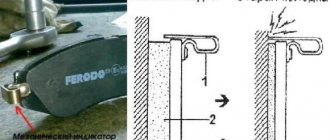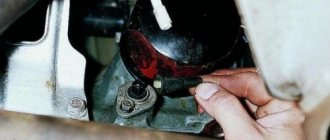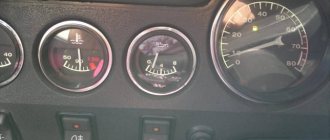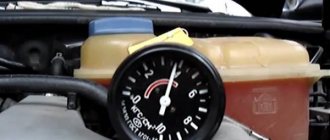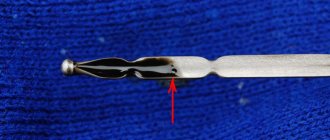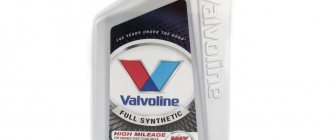the oil light is in an inactive state, that is, it does not light up. If it lights up, this indicates a malfunction, such as a low oil level in the crankcase, low pressure in the engine oil system (for example, the oil filter is clogged, the oil pump is not working well), the oil level sensor has failed, and some other less common. In any case, if the oil pressure light is on or blinking, you must first check the lubricant level. If its indicator is normal, then you need to look for the reason that caused such an indication and eliminate it.
It is extremely undesirable to operate a machine with a low oil level, since under such conditions the engine experiences enormous mechanical and thermal overloads, which reduces its service life and can partially or even completely disable it. If at the moment it is not possible to add oil to at least the minimum (or preferably medium or two-thirds to full) level, then, as a last resort, you can with minimal loads, that is, at medium speeds (not at very low, and not at high speed!) and at low speed drive to a car shop or service center, where you can top up (or completely replace) the engine oil. However, keep in mind that if the store is far away, it is better to leave the car where it is and add oil to it later.
When the oil light (oil can) is on on the panel, it is better to stop driving until the cause is found out, otherwise you can “catch a wedge” of the engine.
Reasons why the oil level light is on
Before looking at the reasons why an oil light might come on, it is necessary to fix the definitions. The warning lamps in the car are controlled by the BCS - the so-called on-board control system. It controls all the lamps displayed on the instrument panel (turn signals on/off, low/high beams, parking brake signal, etc.). Including oil level and pressure lamps. Some cars (newer or more advanced) have separate lamps, while others (older) usually have only one lamp, and it is activated when the lubricating fluid pressure in the crankcase is low. Typically, a yellow icon (oil can) on the dashboard symbolizes low oil level, and a red lamp indicates low pressure. On modern multifunction displays, corresponding inscriptions may appear instead of an “oil can”.
The lamps can be activated separately from one another, since they operate based on data from two sensors (level sensor and engine oil pressure sensor). For example, even when the oil level is low, the oil pump is able to provide sufficient pressure. Although this depends directly on the level, if the level is critically low, then there will be no pressure, but if the level has dropped slightly below the minimum permissible level, then there will still be pressure. And vice versa - if the oil level is within normal limits, then, for example, if the oil filter is clogged, a situation may arise when the pressure in the system is insufficient to effectively lubricate engine parts. A striking example in this case is the situation when, when the crankcase is broken, the low pressure lamp first comes on, and then the low oil level.
Next, let's look at the reasons why the pressure/oil level light may have come on. There are thirteen of them. Let's list them in order from simple to more complex.
Low oil level in the crankcase . This is the simplest problem, and almost anyone, even a novice car enthusiast, can cope with it, without turning to a car service center for help. True, if it is not related to a leak. Any cars, even old carburetor cars, are equipped with an oil pressure sensor.
When its indicator drops below normal, it sends a signal to the ECU (electronic control unit), which, in turn, activates the corresponding lamp on the instrument panel. In this case, the lamp does not blink, but lights up in a constant mode. On modern cars, instead of a warning lamp, the message Check Engine Oil Level may appear, which directly indicates that the driver needs to check the oil level in the crankcase. The situation can happen in any mode of engine operation - at idle, under load, in motion, parked, hot, cold, and so on.
When the ignition is turned on, but the engine is not running (position ON or II), on many cars all the lights and signals on the dashboard are activated, including the oil lamp. However, after starting the engine, most of them go out, including the mentioned indicator.
Measuring the oil level with a dipstick
An interesting case may be when the lamp lights up in certain situations (for example, for a few seconds), and then goes out. This may be the case when the machine is going up or down a steep hill/slope, respectively. In this case, oil can be poured into one of the crankcase volumes - front or rear. And if the oil level sensor is located at its opposite end, this will automatically cause the oil light to light up while driving. A similar situation occurs when driving with a lateral roll or during sharp braking (although in the latter case this is unlikely, and we will look at the reasons why the oil light comes on during braking a little further). If, after returning the car body to its normal horizontal position, the lamp goes out, this means that this is your case, and there is little oil in the engine crankcase.
Incorrectly selected oil . In particular, its viscosity is incorrectly selected, this is especially true for low-temperature viscosity. If it thickens in the cold, then it is difficult for the pump to pump it through the system and the pressure in it is insufficient, which is recorded by the corresponding sensor. Similarly, during the operation of the machine, the viscosity changes (or the oil simply becomes contaminated), which is why a situation may arise when, in certain situations, the pressure sensor is triggered and the oil can indicator will either light up or blink.
Poor quality oil filter . A normal oil filter constantly contains some amount of engine oil. This is done in order to avoid oil starvation when starting the engine. This can be achieved by introducing a check valve or locking washer into its design. These elements ensure that the oil is locked when the engine is turned off. However, on low-quality filters, these elements may either not be present at all or may not fully perform their task. Accordingly, the oil from the filter flows back into the oil pan, and after starting, the engine builds up pressure for the first few seconds. This is a very bad situation, since this results in increased wear of parts, and therefore a decrease in their overall service life. Usually, after starting the engine, the oil light comes on, but soon (after a few seconds/minutes) it goes out.
Clogged oil filter . If the oil filter is heavily clogged, it does not allow the flow of engine oil to pass through it well. This leads, firstly, to a decrease in pressure in the oil system, and secondly, it creates additional load on the oil pump, which reduces its service life and can damage it. In this case, low oil pressure or oil level is often activated. On modern cars equipped with a multifunction display, the words Check Pressure Oil or similar may appear, which translates as “check the engine oil pressure.” Moreover, a similar situation when the oil light is on at idle or at low speeds may indicate that the pressure in the oil system has dropped, and one of the reasons (but not the only one) is a clogged oil filter.
Oil pump pressure reducing valve . This element performs an important function in the car’s oil system, namely, it regulates, that is, prevents the oil level in it from significantly increasing or decreasing. Both of these situations negatively affect the operation of the engine and its individual elements. Most often in this context, the valve spring breaks. Or it simply stretches due to wear and tear or poor quality of the steel from which it is made. Another option is that over time the valve lumen becomes clogged. This is especially true if the car is filled with low-quality dirty oil or the oil filter is already very worn out. If the pressure reducing valve fails when high engine speeds are reached, the oil pressure increases sharply.
Faulty oil level sensor . There are two possible options here. The first, relevant for the problem under consideration, is that when it fails, the oil light is constantly on. This means that its slider is stuck (most often it “gobbled up” oil and drowned) or another breakdown has occurred (depending on the design of the sensor). A direct consequence of this is the fact that the oil pressure light is constantly on.
Another, opposite case, which, however, is not relevant in this topic, is that the sensor does not react in any way to the oil level. Accordingly, if it drops critically, the driver will not know about it unless he manually checks the amount of lubricant in the crankcase using a dipstick. And such a situation is fraught with significant wear and tear on the engine, up to its complete failure.
It is worth noting that the oil level sensor is a fairly reliable device, so it rarely fails. And old devices or devices installed on old cars are susceptible to this (for example, the popular VAZ classic and similar domestic cars). On modern foreign cars, such a breakdown is extremely rare.
Faulty oil pressure sensor . Sometimes situations arise when, for example, in winter in frosty weather, if the engine is not warmed up, it literally “breaks through” the sensor and it begins to leak. Accordingly, it displays pressure incorrectly. For this reason, in winter you should always warm up the engine before driving, although many automakers claim that such a procedure is unnecessary for modern cars.
Clogged oil pump strainer . Here the situation is similar to that described with the oil filter. If it becomes clogged, less oil passes through the mesh than it should, which leads to a decrease in pressure in the system and a decrease in its level. In addition, in such a situation, the oil pump wears out, which significantly reduces its service life.
Faulty oil pump . These devices come in different types - gear, vacuum, rotary. The reasons why it failed will directly depend on this. But in any case, if the oil pump is not working, the pressure in the system will not be maintained, which means the oil light will also blink.
Oil leak . Most often, oil leaks from under various gaskets and sealing rings. Also, the place of leakage can be pipes, oil lines, a breakdown of the cylinder head gasket (in this case, oil and antifreeze are often mixed), and so on. If oil leaks from the system in large quantities, this automatically leads to a situation where the pressure in it drops, which will be indicated by the corresponding light on the dashboard.
Clogged oil passages in the engine . Many modern foreign car engines are structurally made in such a way that the diameter of their oil channels is quite small (for example, this is true for many modern engines installed on cars manufactured by the VAG concern). Therefore, they need to use appropriate high-quality oils that are sufficiently viscous and will not clog the channels, thereby reducing their permeability. In addition, such machines need to be filled with high-quality fuel so that their combustion waste, which gets into the oil in small quantities, also does not clog the oil channels.
Significant wear on engine cylinders/pistons . This happens with old engines and engines that have not been overhauled for a long time. When the cylinder walls are deformed, the so-called waste takes up a much larger amount of oil than is prescribed according to the documentation. Accordingly, when the threshold low oil level in the engine is reached, the warning lamp lights up. And even if you add a certain amount of lubricating fluid, it will soon light up again. Therefore, such motors need to be “overhauled,” that is, comprehensive repairs.
Gasoline or antifreeze getting into the oil . This usually happens when the cylinder head gasket fails. In this case, antifreeze can get into the oil, and it will lose its viscosity characteristics. Often, outwardly, this is expressed by the constant “leakage” of coolant from the system, and the appearance of white smoke from the exhaust pipe may also occur.
How does it work
If everything is fine with the pressure/level, when you start the engine, the oil pressure light comes on only for a short time, then immediately goes out. If the indicator remains active, then it’s time to look for the problem and the fastest ways to eliminate it. On modern cars, the “oiler” can be either red (low engine oil pressure) or yellow (low level), and in some cases it may blink. If the above problems occur, a description of the malfunction may also be displayed on the on-board computer screen.
What to do when the oil light is on
Now that we have looked at the reasons why the oil level light may come on, we can move on to the question of what to do in such a situation. First of all, you need to understand that specific actions directly depend on the reasons why this situation occurred. Therefore, we present the action algorithms in the same sequence as the reasons.
Low oil level . The sequence of actions here depends on the situation in which the red oil light is on. The simplest option is that it caught fire in a garage or parking lot when the engine was running. In this case, you need to turn off the engine again, open the hood, and use the dipstick to measure the oil level in the crankcase. If it is not enough, then you just need to add lubricant approximately 90...95% between the MIN and MAX marks (you also don’t need to fill it to the very edges, this is harmful for the oil system).
When measuring the oil level, the machine must be on a horizontal surface! In addition, level measurements must be carried out regularly, and not just when the oil light comes on!
It is advisable to top up with the same lubricating fluid that was added earlier. To do this, it is better to always have with you in a canister the remaining oil that was filled during replacement. Mixing oils is acceptable, but not recommended. And if you mix oils of the same viscosity and type, but of different brands, this is not so bad, but if you mix oils of different viscosities, and even more so of different types (for example, synthetic and semi-synthetic oil), then it is undesirable to drive with such a composition for a long time. At the first opportunity, it is better to replace the engine lubricant, having first flushed it with a special flushing oil.
Please note that in some cases it is better not to top up, but to completely change the filled oil. First of all, this applies to the situation when the time has come to change the oil according to the regulations.
If the yellow oil light comes on while driving around the city or on the highway and stays on constantly, then the actions are similar. It is necessary to stop in a safe place (on the side of the road, a parking lot), wait a few minutes so that the oil cools down a little and its movement through the system stops. Next, use the dipstick to check its level in the same way. If there is something to add, then you need to do it. If not, you need to go to a car store or car service as soon as possible and buy (replace) the necessary engine oil there. However, you need to drive in a mode that is easy for the engine, that is, at medium speeds and at low speed. If the light comes on on the highway, and the store is still far away, then, as a last resort, you can add other oily liquids to the engine oil, for example, vegetable oil used for food or another similar composition. But, of course, after this, at the first opportunity, such slurry will need to be drained and the oil system flushed.
Clogged or poor quality oil filter . The situation here is also quite simple. It is necessary to remove the mentioned filter with the engine turned off and cool (!!!) and check its condition. Accordingly, if it is very dirty, it means it needs to be replaced. Each car has a certain mileage at which, in accordance with the regulations, it is necessary to change the oil filter. In addition, it must be changed during a complete oil change. You will find additional information on this in the manual for your car.
In addition, you should try to buy high-quality filters. Firstly, they are good at removing debris from engine oil (especially if it is also of poor quality), and secondly, they are good at holding a certain oil mass in their volume, which is necessary for normal engine starting, in order to avoid oil starvation at this moment . You can use both original filters, the brand of which can be found in the manual, and their analogues. But remember that there is always a chance of running into a fake, regardless of whether it is an original or an analogue.
Faulty pressure relief valve . If it fails, you need to dismantle the filter and find the cause of the failure. If the spring has really stretched, try to find a similar one and install it in the seat. If the valve is heavily clogged with debris, it needs to be cleaned, and if there is no other damage, then put it back in place. In general, to prevent its normal operation, it is necessary to carry out the work from the previous paragraph - change the oil filter on time, constantly monitor the condition of the oil and fill in, in fact, high-quality lubricating fluid, without any impurities of solid particles. It is also advisable to flush the oil system before changing the engine oil.
Faulty level sensor . If the design of the device is mechanical, then you can try to dismantle it and clean it. As a rule, due to dirty oil or other reasons, its slider stops in one place and does not respond to changing circumstances. A situation may arise that the float “gobbled up” oil and sank; accordingly, it does not show the real level, but is in the lower position, which is perceived by the ECU as a low level or complete absence of oil. It is necessary to inspect the sensor and then install it in place. Another option is that the wiring from or to the sensor has frayed, that is, it has a short to ground. Naturally, in such conditions, incorrect signals will travel through the wires. If the revision does not help, replace the sensor with a new one. If you do not have experience in performing the relevant work, it is better to take the car to a car service for servicing.
Faulty oil pressure sensor . The situation is similar here. It needs to be reviewed. And performance can be checked using a multimeter and/or pressure gauge. As a rule, if the sensor fails, then it only needs to be replaced; unfortunately, it cannot be repaired. At the same time, you need to inspect whether its electrical terminal has come off the contact, that is, whether the sensor is connected to the electrical/signal system of the car, whether signals are sent from it to the ECU.
How to check the oil pressure sensor
To check with your own hands whether the oil pressure sensor is working correctly, you will need a multimeter or a test light. The main way to check it is to measure the resistance, but you can verify its functionality with a pressure gauge Read more
Clogged oil pump strainer . It is necessary to dismantle it and clean it, and then install it in place. In this case, it is necessary to evaluate the condition of the oil and the general oil pump. If the oil is dirty and the filter is clogged, both need to be changed.
Faulty oil pump . Regardless of its design, it is necessary to check how it works, as well as the efficiency of operation. If any malfunctions are detected, the pump must be dismantled and repaired attempted. If this fails, it means that this unit must be completely replaced. When you are not able to repair the oil pump yourself, it makes sense to seek help from a car service center.
In this regard, it is possible that the oil pump is working properly, but its technical parameters are designed to pump oil with a different viscosity. That is, it is possible that a car owner has filled in motor oil with a viscosity that is not recommended by the car manufacturer. If the lubricating fluid is very thick (more viscous or simply very dirty), then the pump may not be able to pump it, and accordingly, the pressure in the system will be less than it should be. This will not only cause the oil light to light up on the dashboard, but also cause the pump to operate in extreme mode, which will automatically reduce its service life and put it at risk of premature failure.
Oil leakage from the system . If you constantly encounter a problem where the engine “eats up” oil, then you need to look for the reason where it might go. Each car has a so-called “normal” consumption, which is directly indicated in the documentation. However, if this value increases excessively, diagnostics must be performed. To do this, you need to inspect the elements of the fuel system, check the condition of the cylinders and pistons, the condition of the cylinder head gasket and the head itself, look for oil stains on the engine elements, whether the oil is mixed with antifreeze, and so on. Most often, leaks occur from under various seals and seals. If you are unable or do not want to do such work, contact a car service center for help, the specialists will do this work for you.
Significant wear on cylinders/pistons . It is necessary to assess their condition. First of all, it makes sense in this case to check the compression. An indirect, but not the only, sign that the cylinders have worn out significantly is the appearance of blue smoke from the exhaust pipe. This diagnosis is best performed in a car service using special equipment. In the event that the engine is really in a pre-repair condition, it makes sense to sharpen the cylinders and perform the so-called “overhaul”. This will also reduce oil consumption, which means the oil light on the dashboard will no longer bother you.
Broken cylinder head gasket . This is a very dangerous situation, and if it is identified, it is necessary to carry out repair work as quickly as possible, since driving with a broken head is very dangerous for the engine, there is a risk that the engine will “knock”, that is, fail.
When the engine heats up, the oil pressure lights up: consequences for the engine
Let's start with the fact that any problems with lubricant pressure mean that the power unit is experiencing oil starvation. Simply put, the rubbing surfaces do not receive enough motor oil and their wear begins to increase. Oil also plays the role of a cleaner and cooler, washing away wear products and lowering the temperature in the area where the surfaces of rubbing pairs work.
This means that if there is not enough lubrication or the pressure is weak, then there is also a high probability of local overheating and damage to the loaded rubbing surfaces by wear products (metal shavings, etc.). It is not difficult to guess that in such cases, scoring on the cylinder bore may form in the engine, and sliding bearings and other important elements may fail.
Also, when the efficiency of the oil system decreases, knocks and noises appear in the engine, which subsequently lead to more serious damage or even engine seizure. In this case, jamming may well be accompanied by a “fist of friendship,” which greatly complicates the repair of the damaged unit and increases the overall costs of restoring the internal combustion engine.
Rare causes of oil light activation
There are a number of other unlikely reasons why the oil light on the dashboard may come on. In particular:
- Faulty wiring and/or vehicle ECU . In the first case, for example, the insulation of individual wires may be damaged, causing a false signal to be sent through the wiring to the light bulb. However, in most cases, this situation is monitored by the electronic control unit and it will automatically notify the driver about such a breakdown through the Check Engine lamp (for this you need to have an error scanner such as ELM 327). As for the ECU, this could be a banal “glitch”, that is, a computer program failure. However, this happens extremely rarely, and it makes sense to check the control unit if there are other, more complex, breakdowns. Sometimes you can find information on forums that the cause may be poor-quality soldering of one or more tracks of the control unit. Accordingly, they need to be re-soldered, but for this it is better to seek help from a car service center that has the appropriate equipment and qualified personnel.
- The oil filter was not changed during the oil change . In particular, this may cause the light to come on after an oil change. Remember that the filter must be changed when replacing the lubricant . If you have driven very little after the corresponding replacement, then you can replace this unit with a new one. If the mileage is already quite large, then it is better to change the oil again and this time together with installing an oil filter. A similar situation can occur if the new oil filter was not tightened tightly enough (the torque value must be observed, and you can find it in the technical documentation for the car) or is simply defective.
- When starting the engine in severe frosts, the oil light may light up for the first few seconds and then go out . This is due to the fact that at low temperatures the oil becomes very thick and it is difficult for the oil pump to pump it through the system; accordingly, insufficient pressure (and often vacuum) is created in it, which is perceived by the corresponding sensor as a malfunction. However, after a few seconds/minutes, the oil regains its fluidity and the pressure in the system returns to normal; accordingly, the sensor detects this, transmits a signal to the computer, and the light goes out. Please note that you should always choose oil not only in accordance with the recommendations of the car manufacturer (usually it allows the use of oils with several similar viscosities), but also with the operating conditions of the car. In particular, we are talking about low-temperature viscosity. A similar situation can occur after the car has been parked for a long time without starting the engine (for example, several months), especially if there is old (dirty) oil in the crankcase.
How far can you drive if the oil light is on?
Also, many car enthusiasts are interested in the question of how long can you drive when the oil light comes on? The answer to it depends on the reason why such a situation was caused. From general considerations, we can say that when the lamp comes on, the first thing to do is check the oil level. And if it is below the minimum value, and there is nothing to add, then with a low level you can drive literally several kilometers with a minimum load on the engine (that is, with average engine speed and at low speed) to the place where you can add/change the oil.
There you need to perform additional diagnostics, since activation of the lamp may indicate not only a low oil level, but also other reasons listed above. You cannot operate a vehicle with a low (below the minimum required value) oil level in the engine crankcase. This leads to significant wear and the risk of complete failure of the power unit. Of course, this leads to significant costly repairs!

